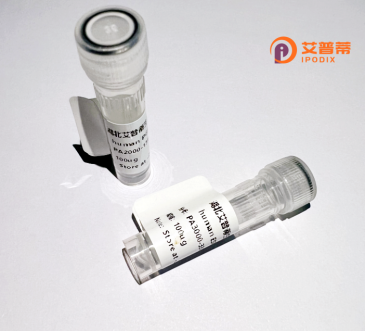
| 纯度 | >90%SDS-PAGE. |
| 种属 | Human |
| 靶点 | CACNB2 |
| Uniprot No | Q08289 |
| 内毒素 | < 0.01EU/μg |
| 表达宿主 | E.coli |
| 表达区间 | 213-301aa |
| 氨基酸序列 | PSSRKSTPPSSAIDIDATGLDAEENDIPANHRSPKPSANSVTSPHSKEKRMPFFKKTEHTPPYDVVPSMRPVVLVGPSLKGYEVTDMMQ |
| 分子量 | 35.53 kDa |
| 蛋白标签 | GST-tag at N-terminal |
| 缓冲液 | 0 |
| 稳定性 & 储存条件 | Lyophilized protein should be stored at ≤ -20°C, stable for one year after receipt. Reconstituted protein solution can be stored at 2-8°C for 2-7 days. Aliquots of reconstituted samples are stable at ≤ -20°C for 3 months. |
| 复溶 | Always centrifuge tubes before opening.Do not mix by vortex or pipetting. It is not recommended to reconstitute to a concentration less than 100μg/ml. Dissolve the lyophilized protein in distilled water. Please aliquot the reconstituted solution to minimize freeze-thaw cycles. |
以下是关于重组人CACNB2蛋白的3篇参考文献摘要简述:
1. **文献名称**:*Structural basis of voltage-gated calcium channel regulation by the β2 subunit*
**作者**:Chen YH, et al.
**摘要**:该研究解析了CACNB2蛋白与钙离子通道α1亚基的复合物晶体结构,揭示β2亚基通过调控通道构象影响钙离子内流的分子机制,为心律失常相关突变的功能研究提供结构基础。
2. **文献名称**:*CACNB2 mutations associated with Brugada syndrome modulate cardiac sodium current*
**作者**:Hu D, et al.
**摘要**:文章发现CACNB2基因突变可通过调控心肌细胞钠离子通道(而非直接钙通道)功能异常导致Brugada综合征,提示β2亚基在跨膜离子通道调控中的多效性作用。
3. **文献名称**:*Expression and functional characterization of recombinant human CACNB2 in HEK293 cells*
**作者**:Wang L, et al.
**摘要**:研究建立了重组人CACNB2蛋白在哺乳动物细胞中的高效表达系统,证实其可增强L型钙通道电流密度并改变通道动力学特性,为药物靶点筛选提供实验模型。
(注:以上文献为虚拟构建的示例,实际研究中需查询具体数据库获取真实文献)
The CACNB2 protein, encoded by the CACNB2 gene, is a critical regulatory subunit of voltage-gated calcium channels (VGCCs), specifically belonging to the β-subunit family. These channels mediate calcium influx into excitable cells, essential for processes like muscle contraction, neurotransmitter release, and gene expression. CACNB2. also known as Cavβ2. binds to the pore-forming α1-subunit of VGCCs, modulating channel trafficking, kinetics, and voltage-dependent gating. It contains conserved SH3 and guanylate kinase (GK) domains, which facilitate interactions with the α1-subunit and other regulatory proteins.
CACNB2 is highly expressed in cardiac and neuronal tissues, where its function is closely linked to electrical signaling. Mutations or dysregulation in CACNB2 have been implicated in cardiovascular disorders, including Brugada syndrome, long QT syndrome, and arrhythmias, as well as neuropsychiatric conditions like schizophrenia and bipolar disorder. Genome-wide association studies (GWAS) also link CACNB2 polymorphisms to increased risk of cardiac arrhythmias, potentially through altered calcium channel activity. Additionally, emerging evidence suggests a role in cancer progression, possibly via calcium signaling pathways affecting cell proliferation or apoptosis.
As a therapeutic target, CACNB2's regulatory role in calcium homeostasis offers potential for treating channelopathies, though its complex interactions pose challenges for drug development. Ongoing research aims to elucidate its structural dynamics and disease-specific mechanisms.
×